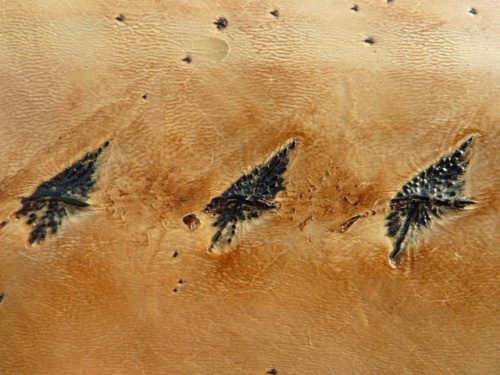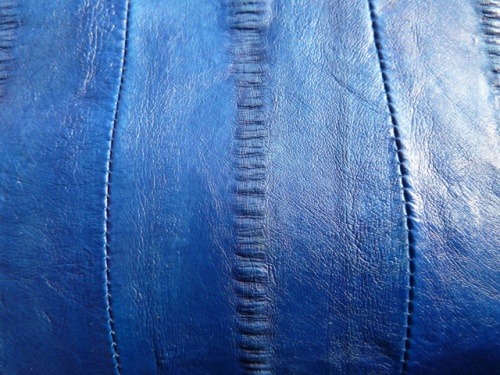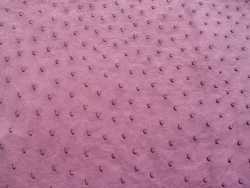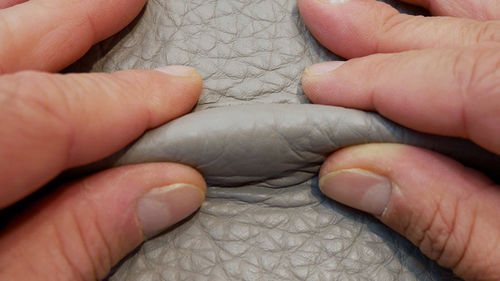Leather grain - Grain side
Contents
- 1 Top grain leather - Hair side
- 2 Types of graining: fine pore leather - coarse pore leather - fine grain leather - coarse grain leather
- 3 Graining of different animals
- 4 Embossed leather
- 5 Compressing and stretching leather grain
- 6 Coated leather
- 7 Video about laminated split leather (PU split leather)
- 8 Additional information
Top grain leather - Hair side
The grain side refers to the smooth, grained surface facing the hair side (or the outside, if no hair is present) in leather. Each type of leather has a unique characteristic grain pattern. The pore density is much heavier on cow leather than on pig leather. The grain pattern can be changed by embossing and colouration. Even split leather can be coated in such a way that it appears like top grain leather.
The side of the skin facing the meat of the animal is called the flesh side.
Types of graining: fine pore leather - coarse pore leather - fine grain leather - coarse grain leather
The original grain pattern already differs on the same animal skin surface. In the middle of a skin, the leather is mostly fine-pored, and towards the edge it becomes more coarse-pored. The appearance of an even skin structure is often disrupted by deeper natural wrinkles.
On same skin: fine pored -> transition -> coarse pored.
The main grain is partially traversed by deeper natural folds.
When cutting, care must be taken that the grain pattern is chosen as symmetrically as possible.
Graining of different animals
Natural grain pattern: Sturgeon leather - Elephant leather - Crocodile leather
Natural grain pattern: Pig leather - Stingray leather - Ostrich leather
Natural grain pattern: Eel leather - Aga-toad - Atlantic stingray leather
Natural grain pattern: Boa constrictor - Shark leather - Chicken legs leather
Natural grain pattern: Kangaroo leather - Carp leather - Salmon leather
Natural grain pattern: Hippo Leather - Moray eel leather - Python leather
Natural grain pattern: Yak leather- Ostrich leather - Sealskin leather
Embossed leather
Grain side, but with embossing: furniture leather with distinctive pattern embossing. - Car leather (cow) with embossing of pig leather. - Crocodile embossing on cow leather.
Compressing and stretching leather grain
Sometimes the grain in the leather has become smoother due to tension or stretching. For smaller surfaces and areas, you can try to strengthen the grain by compressing it. The effect is not as lasting as with an embossing, but sometimes it is sufficient. Important! Do not stretch the leather again afterwards, otherwise the effect will be gone again immediately.
A leather grain can be locally reinforced by compressing.
There is also the opposite situation, that a grain is too strong and should be smoothed. In local areas, the leather surface can be pulled and stretched. As a result, the grain structure flattens out.
A leather grain can be smoothed locally by pulling and stretching.
Coated leather
Only at the first glance Top grain leather: Foil-coated split leather. - Inexpensive, inferior, coated split leather.
Video about laminated split leather (PU split leather)
Video about the manufacturing of laminated split leather.
Additional information
- Flesh side
- Top grain leather
- Full grain leather
- Natural leather grain
- Embossed leather
- Corrected Grain
- Fine pore leather - Coarse pore leather - Fine grain leather - Coarse grain leather











































 a kotori web solution
a kotori web solution